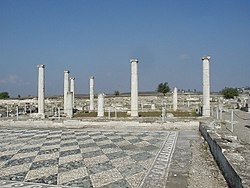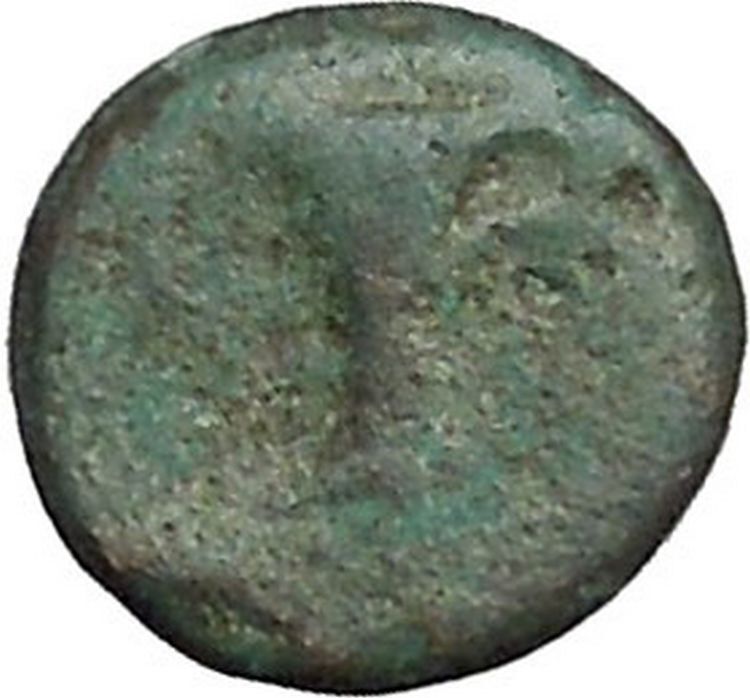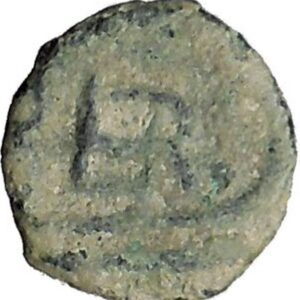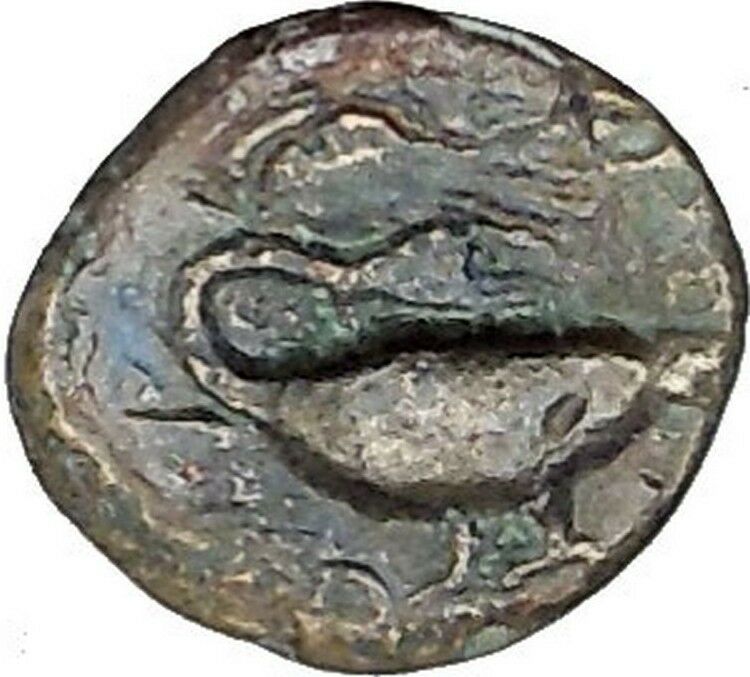|
Greek city of Pella in Macedonia
Bronze 17mm (4.39 grams) Struck 158-88 B.C.
Reference: Sear 1447; B.M.C. 5.14
Laureate head of Apollo right.
ΠEΛ-ΛHΣ either side of tripod.
Pella became the capital of the Macedonian kingdom under
Archelaus, in succession to Aigai. Following the Roman conquest in 168 B.C.,
Pella was the capital of the third republic. Its issues are often in the name of
the Bottiaians, the original inhabitants of the district in which Pella was
situated.
You are bidding on the exact
item pictured, provided with a Certificate of Authenticity and Lifetime
Guarantee of Authenticity.

In
Greek
and
Roman mythology
, Apollo
,
is one of the most important and diverse of the
Olympian deities
. The ideal of the
kouros
(a
beardless youth), Apollo has been variously recognized as a god of light and the
sun; truth and prophecy;
archery
;
medicine and healing; music, poetry, and the arts; and more. Apollo is the son
of Zeus
and
Leto, and has a
twin
sister, the chaste huntress
Artemis
.
Apollo is known in Greek-influenced
Etruscan mythology
as Apulu. Apollo was worshiped in both
ancient Greek
and
Roman religion
, as well as in the modern
Greco
–Roman
Neopaganism
.
As the patron of Delphi
(Pythian Apollo), Apollo was an
oracular
god — the prophetic deity of the
Delphic Oracle
.
Medicine and healing were associated with Apollo, whether through the god
himself or mediated through his son
Asclepius
,
yet Apollo was also seen as a god who could bring ill-health and deadly
plague
as well as one who had the ability to cure. Amongst the god’s
custodial charges, Apollo became associated with dominion over
colonists
, and as the patron defender of herds and flocks. As the leader of
the Muses
(Apollon
Musagetes) and director of their choir, Apollo functioned as the patron god
of music and poetry
.
Hermes
created
the lyre
for him,
and the instrument became a common
attribute
of Apollo. Hymns sung to Apollo were called
paeans
.
In Hellenistic times, especially during the third century BCE, as Apollo
Helios he became identified among Greeks with
Helios
,
god of
the sun
, and his sister Artemis similarly equated with
Selene
,
goddess
of the moon
.
In Latin texts, on the other hand, Joseph Fontenrose declared himself unable to
find any conflation of Apollo with
Sol
among the
Augustan poets
of the first century, not even in the conjurations of
Aeneas
and
Latinus
in
Aeneid
XII
(161–215).
Apollo and Helios/Sol remained separate beings in literary and mythological
texts until the third century CE.
A sacrificial tripod was a type of
altar
used by the
ancient Greeks. The most famous was the
Delphic
tripod
, on
which the Pythian
priestess
took her seat to deliver the
oracles
of the
deity. The seat was formed by a circular slab on the top of the tripod, on which
a branch of
laurel
was deposited when it was unoccupied by the priestess. In this sense,
by Classical times the tripod was sacred to
Apollo
. The
mytheme
of
Heracles
contesting with Apollo for the tripod appears in vase-paintings older than the
oldest written literature. The oracle originally may have been related to the
primal deity, the Earth.
Another well-known tripod was the
Plataean Tripod
, made from a tenth part of the spoils taken from the
Persian
army after the
Battle of Plataea
. This consisted of a golden basin, supported by a
bronze
serpent
with three heads (or three serpents intertwined), with a list of the
states that had taken part in the war inscribed on the coils of the serpent. The
golden bowl was carried off by the
Phocians
during
the
Third Sacred War
; the stand was removed by the emperor
Constantine
to
Constantinople
(modern
Istanbul
),
where it still can be seen in the
hippodrome
, the Atmeydanı, although in damaged condition, the heads
of the serpents disappeared however one is now on display at the nearby Istanbul
Archaeology Museums. The inscription, however, has been restored almost
entirely. Such tripods usually had three ears (rings which served as
handles) and frequently had a central upright as support in addition to the
three legs.
Tripods frequently are mentioned by
Homer
as prizes
in
athletic games
and as complimentary gifts; in later times, highly decorated
and bearing inscriptions, they served the same purpose. They also were used as
dedicatory offerings
to the deities, and in the dramatic contests at the
Dionysia
the victorious
choregus
(a wealthy citizen who bore the expense of equipping and training
the chorus) received a crown and a tripod. He would either dedicate the tripod
to some deity or set it upon the top of a marble structure erected in the form
of a small circular temple in a street in
Athens
, called
the street of tripods, from the large number of memorials of this kind.
One of these, the
Choragic Monument of Lysicrates
, erected by him to commemorate his victory
in a dramatic contest in
335 BC
, still
stands. The form of the victory tripod, now missing from the top of the
Lysicrates monument, has been rendered variously by scholars since the
eighteenth century.
The scholar
Martin L. West
writes that the sibyl at Delphi shows many traits of
shamanistic
practices, likely inherited or influenced from Central Asian
practices. He cites her sitting in a cauldron on a tripod, while making her
prophecies, her being in an ecstatic trance state, similar to shamans, and her
utterings, unintelligible.
According to Herodotus (The Histories, I.144), the victory tripods were not
to be taken from the temple sanctuary precinct, but left there for dedication.
Pella (Greek:
Î Îλλα), an ancient city located in
Pella Prefecture
of
Macedonia
in Greece
, was the
capital
of the
ancient
kingdom
of
Macedon
. A common
folk etymology
is traditionally given for the name Pella, ascribing
it to a form akin to the
Doric
Apella
,
originally meaning a ceremonial location where decisions were made.
However, the local form of Greek was not Doric, and the word exactly matches
standard Greek pélla “stone”, undoubtedly referring to a famous landmark
from the time of its foundation.
//
History
The city was founded by
Archelaus
(413–399
BC) as the capital of his kingdom, replacing the older palace-city of
Aigai
(Vergina).
After this, it was the seat of the king
Philip II
and of
Alexander
, his son. In
168 BC
, it was
sacked by the
Romans
,
and its treasury transported to
Rome. Later, the
city was destroyed by an
earthquake
and eventually was rebuilt over its ruins. By 180 AD,
Lucian
could
describe it in passing as “now insignificant, with very few inhabitants”.
Pella is first mentioned by
Herodotus
of
Halicarnassus
(VII, 123) in relation to
Xerxes
‘ campaign and by
Thucydides
(II, 99,4 and 100,4) in relation to Macedonian expansion and the war against
Sitalces
,
the king of the Thracians
. According to
Xenophon
,
in the beginning of the 4th century BC, it was the largest Macedonian city. It
was probably built as the capital of the kingdom by Archelaus, although there
appears to be some possibility that it may have been
Amyntas
. It attracted Greek artists such the painter
Zeuxis
, the poet
Timotheus
of
Miletus
and the
tragic author
Euripides
who finishes his days there writing and producing Archelaus.
Archelaus invited the painter
Zeuxis
, the
greatest painter of the time, to decorate it. He was later the host of the
Athenian playwright
Euripides
in his retirement. Euripides
Bacchae
premiered here, about
408 BC
. Pella
was the birthplace of Philip II and of Alexander, his son. The hilltop
palace
of
Philip, where Aristotle
tutored young Alexander, is being excavated.
In antiquity, Pella was a port connected to the
Thermaic Gulf
by a navigable
inlet
, but the
harbor has silted, leaving the site landlocked. The reign of
Antigonus
likely represented the height of the city, as this is the period
which has left us the most archaeological remains.
Pella is further mentioned by
Polybius
and Livy
as the
capital of
Philip V
and of
Perseus
during the
Macedonian Wars
, fought against the
Roman Republic
. In the writings of Livy, we find the only description of how
the city looked in 167 BC
to
Lucius Aemilius Paulus Macedonicus
, the Roman who defeated Perseus at the
battle
of Pydna
:
- …[Paulus] observed that it was not without good reason that it had been
chosen as the royal residence. It is situated on the south-west slope of a
hill and surrounded by a marsh too deep to be crossed on foot either in
summer or winter. The citadel the “Phacus,” which is close to the city,
stands in the marsh itself, projecting like an island, and is built on a
huge substructure which is strong enough to carry a wall and prevent any
damage from the infiltration from the water of the lagoon. At a distance it
appears to be continuous with the city wall, but it is really separated by a
channel which flows between the two walls and is connected with the city by
a bridge. Thus it cuts off all means of access from an external foe, and if
the king shut anyone up there, there could be no possibility of escape
except by the bridge, which could be very easily guarded.. [3]
The famous poet Aratus
died in Pella ca
240 BC
. Pella
was sacked by the Romans in
168 BC
, when
its treasury was transported to Rome.
In the
Roman province of Macedonia
, Pella was the capital of the third district,
and was possibly the seat of the Roman governor. Crossed by the
Via
Egnatia
[4],
Pella remained a significant point on the route between
Dyrrachium
and
Thessalonika
. Cicero
stayed there in
58 BC
, but by
then the provincial seat had already transferred to Thessalonika. It was then
destroyed by earthquake in the first century BC; shops and workshops dating from
the catastrophe have been found with remains of their merchandise. The city was
eventually rebuilt over its ruins, which preserved them, but, ca
AD 180
,
Lucian
of Samosata
could describe it in passing as “now insignificant, with very few
inhabitants”
The city went into decline for reasons unknown (possibly an earthquake) by
the end of the 1st century BC. It was the object of a colonial deduction
sometime between 45 and
30 BC
; in any
case currency was marked Colonia Iulia Augusta Pella.
Augustus
settled peasants there whose land he had usurped to give to his veterans (Dio
Cassius LI, 4). But unlike other Macedonian colonies such as
Philippi
,
Dion
, and
Cassandreia
it never came under the jurisdiction of
ius
Italicum
or Roman law. Four pairs of colonial magistrates (IIvirs
quinquennales) are known for this period.
The decline of the city was rapid, in spite of colonization:
Dio
Chrysostom
( 33.27Or.)
and Lucian
both
attest to the ruin of the ancient capital of Philip II and Alexander; though
their accounts may be exaggerated. In fact, the Roman city was somewhat to the
west of and distinct from the original capital; which explains some
contradictions between coinage,
epigraphs
, and testimonial accounts. In the Byzantine period, the Roman site
was occupied by a fortified village.
The
site
Urban
area
The city is built on the
island
of Phacos
, a
promontory
which dominates the wetlands which encircle Pella to the south, and a lake which
opened to the sea in the
Hellenistic period
.
Palace
The city wall mentioned by Livy is only partly known. It consists of a
rampart of crude bricks (about 50 cm square) raised on a stone foundation; some
of which has been located North of the palace, and some in the South next to the
lake. Inside the ramparts, three hills occupy the North, and the palace is
situated on a place of honour on the central hill. Partly searched, it occupied
a considerable area of perhaps 60,000 square metres). The plan is still not well
known, but has been related to that of the city plan (see diagram).
The Pella palace consisted of several — possibly seven — large architectural
groupings juxtaposed in two rows, each including a series of rooms arranged
around a central square courtyard, generally with porticos. Archaeologists have
thus far identified a
palaestra
and baths
. The south facade of the palace, towards the city, consisted of one
large (at least 153 metres long) portico, constructed on a two metres high
foundation. The relationship between the four principal complexes is defined by
an interruption in the portico occuupied by a triple
propylaeum
, 15 m high, which gave the palace an imposing monumental air when
seen from the city below.
Dating of the palace has posed some problems: the large buildings could date
the reign of Philip II, but other buildings appear to be earlier. The baths date
from the reign of
Cassander
.
The size of the complex indicates that, unlike the palace at Vergina, this
was not only a royal residence or a grandiose monument but also a place of
government which was required to accommodate a portion of the administrative
apparatus of the kingdom.
Hippodamean
plan
The city proper was located south of and below the palace. Designed on a
grid plan
as envisaged by
Hippodamus
, it consists of two series of parallel streets which intersect at
right angles and form a grid of eight rows of rectangular blocks. These blocks
are of a consistent width — each approximately 45 m — and a length which varies
from 111 m to 152 m, 125 metres being the most common. The streets are from 9 to
10 metres wide, except for the middle East–West arterial, which is up to 15
metres wide. This street is the primary access to the central public
agora
, which
occupied a space of ten blocks. Two North-South streets area also a bit wider
than the rest, and serve to connect the city to the port further South. The
streets had sewers and were equipped to convey water to individual residences.

Lion Hunt Mosaic in Pella
This type of plan dates to the first half of the fourth century BC, and is
very close to the ideal in design, though it distinguishes itself by large block
size; Olynthus
in
Chalcidice
for example had blocks of 86.3×35 metres. On the other hand,
later Hellenistic urban foundations have blocks comparable to those of Pella:
112×58 m in Laodicea ad Mare
, or 120×46 m in
Aleppo
.
The agora holds pride of place in the centre of the city, occupying an
imposing 200 by 181 metres; 262×238 metres if one counts the potrticos which
surround it on all sides.
Archaeology
Based on the descriptions provided by
Titus Livius
, the site was explored by 19th-century voyagers including
Holand, Pouqueville, Beaujour, Cousinéry, Delacoulonche, Hahn, Glotz and Struck.
The first excavation was begun by G. Oikonomos in 1914–15. The modern systematic
exploration of the site began in 1953 and full excavation was being done in
1957. The first series of campaigns were completed in 1963, more excavations
following in 1980. These digs continue in the section identified as the agora.
In February 2006, a farmer accidentally uncovered the largest tomb ever found
in Greece. The names of the noble
ancient Macedonian
family are still on inscriptions and painted sculptures
and walls have survived. The tomb dates to the
2nd
or 3rd century BC, following the rule of Alexander the Great.[6]

An atrium with a pebble-mosaic paving
Archaeological digs in progress since 1957 have uncovered a small part of the
city, which was made rich by Alexander and his heirs. The large agora or market
was surrounded by the shaded colonnades of
stoae, and streets
of enclosed houses with frescoed walls round inner courtyards. The first
trompe-l’oeil
wall murals imitating perspective views ever seen were on
walls at Pella. There are
temples
to Aphrodite
,
Demeter
and
Cybele
, and
Pella’s pebble-mosaic floors, dating after the lifetime of Alexander, are
famous: some reproduce Greek paintings; one shows a lion-griffin attacking a
stag, a familiar motif also of
Scythian
art, another depicts
Dionysus
riding a leopard.
|










